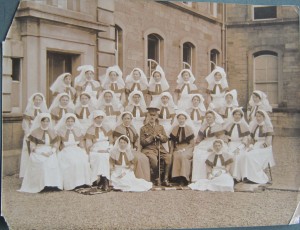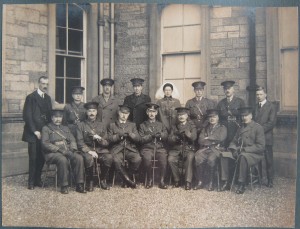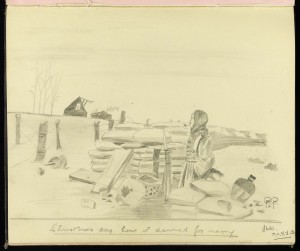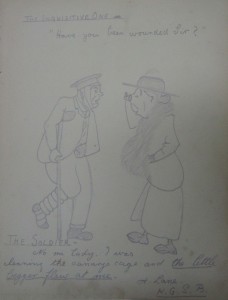In this edition of Untold Stories, Louise (Archivist at Lothian Health Services Archive) looks at the history of one of the many military hospitals in our region:
During the current centenary of the First World War, LHSA has received a number of requests for records of patients in the many military hospitals in and around Edinburgh: from Red Cross auxiliary hospitals to specialist units and existing medical facilities that were requisitioned by the authorities. Due to the fact that medical records of service patients were returned to the custody of the Public Record Office in London (many of which were subsequently destroyed in a Second World War bombing raid), we are unable to help with these enquiries, even if we have custody of patient records generated by requisitioned local hospitals in peacetime. If you are researching the individual records of a forces’ patient or member of military medical staff, there are some resources that may help you at the end of the blog. However, LHSA holds a number of privately donated resources that uncover the realities of hospital life for First World War patients and medical staff alike, supplementing the ‘official’ military record.
One of Edinburgh’s military hospitals was the Second General Military Hospital, Craigleith. The hospital was run by a Territorial Unit, who requisitioned the hospital wing of the Craigleith Hospital and Poorhouse. The first patient was received as early as August 1914, and the hospital was handed back to Edinburgh Town Council in Spring 1919. When the Local Government (Scotland) Act (1929) came into force, control of poorhouses and poorlaw hospitals transferred to the municipal authorities. The poorhouse at Craigleith became an institution that is still very much alive today – the Western General Hospital (WGH).
Exterior of the Second General Military Hospital, Craigleith (GD28)
LHSA is lucky enough to hold a number of items that bring the days of the Second General Military Hospital more sharply into focus for researchers. In addition to his specialism of gastroenterology, WGH Consultant Dr Martin Eastwood was also a hospital historian – in 1995, a book on the development of the WGH was published, written by Eastwood and his secretary, Anne Jenkinson. The sources used by Dr Eastwood were donated to us in 2009, and form a largely visual collection on the history of the hospital, starting from its opening as a poorhouse in 1867.
Among Dr Eastwood’s donation was a photograph album from the Second General Military Hospital. We do not know who gave the album to Dr Eastwood, but its images give a unique insight into hospital life.
The Craigleith photograph album (GD28/8/1)
For example, we can see the operating theatre that was built for the new military patients, and used by the WGH up to 1950 (though hopefully conditions had moved on a bit by then!):
New operating theatre in action, c. 1914 (GD28/8/1)
The hospital was headed by Colonel Sir Joseph Fayrer and its clinical staff made up of Edinburgh doctors, many of whom had (or were to have) distinguished medical careers (such as neurologist Edwin Bramwell and pioneer of modern dentistry William Guy). Nurses were for the most part untrained – local women who were members of Voluntary Aid Detachments (VADs):
Nurses and male medical staff at Craigleith in the Eastwood album (GD28/8/1)
Recuperation was not always solely medical – the hospital laid on various activities in order to make the soldier patients’ time more pleasurable. We have evidence of this in surviving copies of the hospital magazine, the Craigleith Hospital Chronicle. You can see a complete edition on the LHSA website, here. The Chronicle was a monthly publication started in 1914 by Craigleith nurse Annie Paulin. The copies that LHSA hold show images of hospital life, patients and staff, publish informational pieces on Scottish regiments, tell of social occasions at the hospital, showcase story serials and commemorate major events in the war, such as the rail disaster at Quintinshill (Gretna), which claimed the lives of 216 Royal Scots soldiers and 12 civilians:
 Poem to the victims at Gretna, June 1915 edition (GD28/6/1)
Poem to the victims at Gretna, June 1915 edition (GD28/6/1)
The Chronicle also had a regular feature (cue plug for my last blog!) titled A Nurse’s Notes from Serbia written by ‘M.T.F’ (one of the infuriating things about trying to trace authors in this magazine is that many contributions were only signed by initials!). M.T.F wrote about life at the front as a Scottish Women’s Hospital nurse:
 Craigleith Hospital Chronicle, December 1915 (GD1/82/11)
Craigleith Hospital Chronicle, December 1915 (GD1/82/11)
If you’d like to guess the identity of M.T.F, the excellent nursing history website Scarlet Finders lists all Scottish Women’s Hospital nurses.
However, not all Chronicle articles took such a serious note. For example, comic poems and occasionally cartoons took a turn to supplement more ‘educative’ material:


Lighter material from the same December 1915 edition (GD1/82/11)
Unless patients signed articles or poems in the Chronicle, we have little idea of who they actually were from the material that we hold at LHSA. Fortunately, we do hold another piece of evidence in an autograph book created by Craigleith nurse Sister Ethel Miller from 1916 to 1919.
Rather than the celebrity signatures that fill autograph books of the modern day, these small volumes were passed from nurses to soldier patients on the wards, who contributed sketches, cartoons, anecdotes and poetry. Keeping these books appears to have been common practice for nurses, and many survive in archive collections across the United Kingdom (including this one in the National Museum of Scotland).
Born in 1888 in Edinburgh, Ethel was a professional nurse before the war, qualifying from the Royal Infirmary of Edinburgh School of Nursing and from the wartime Territorial Nursing Service in 1916. Along with photographs, printed material and nursing certificates, Ethel’s scrapbook was generously bequeathed to LHSA in 2012 by her son.
 Sister Ethel Miller (Acc12/025)
Sister Ethel Miller (Acc12/025)
Sister Miller issued instructions to her potential contributors: according to a poem in the volume, she wanted ‘not just a name’, but ‘something else besides’, a more personal contribution from her charges in the form of a verse, a joke or a drawing. The result of her instructions is a fascinating insight into the often battle-scarred and weary ordinary ‘Tommy’ – we know that most contributors in the book were from the rank of private by the signatures after each drawing, poem or anecdote
Although not all of the completed pages are signed, there were at least 43 different contributors. The soldiers (for the contributors were largely from the army) wrote poems, limericks, drew original cartoons, traced published images with blotting papers and sketched regimental badges and front-line experience. Some praised the bravery of their regiment, as did Private A. Lane of the Kings Own Scottish Borderers in October 1916, which was ‘a credit to his friends and a terror to his foes’. However, the main themes of the book do not concentrate on heroism on the field of battle, but on war’s drudgery and the after effects of conflict, whether that was the domestic regimes of hospital life, reaction from civilians at home to returning war wounded (as new technologies of battle left maimed soldiers as physical reminders of the effects of war) and the misery of life in the trenches.
Cartoons from Ethel’s autograph book (Acc12/025)
In 2013, LHSA Research Intern Kirstin Cunningham saw the potential of Ethel Miller’s book for use in education, as an object that could bring the war directly to students through ordinary soldiers’ experiences. As a photography and film graduate, Kirstin painstakingly re-created the scrapbook page by page through digital imaging, fixing each image into a modern, similar sized book that she distressed to resemble its original. Soldiers’ stories can now be literally taken out of the archive, even if we will never know all of their names.
 Craigleith soldier patients at a concert in the recreation room (GD28/8/1)
Craigleith soldier patients at a concert in the recreation room (GD28/8/1)
Further resources on tracing military records from the First World War:
http://bit.ly/1NUdbde
http://bit.ly/1NUdrZR
http://www.scarletfinders.co.uk/125.html
http://bit.ly/1U6maz1







